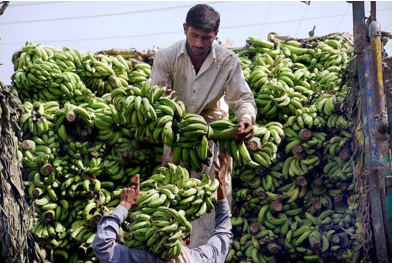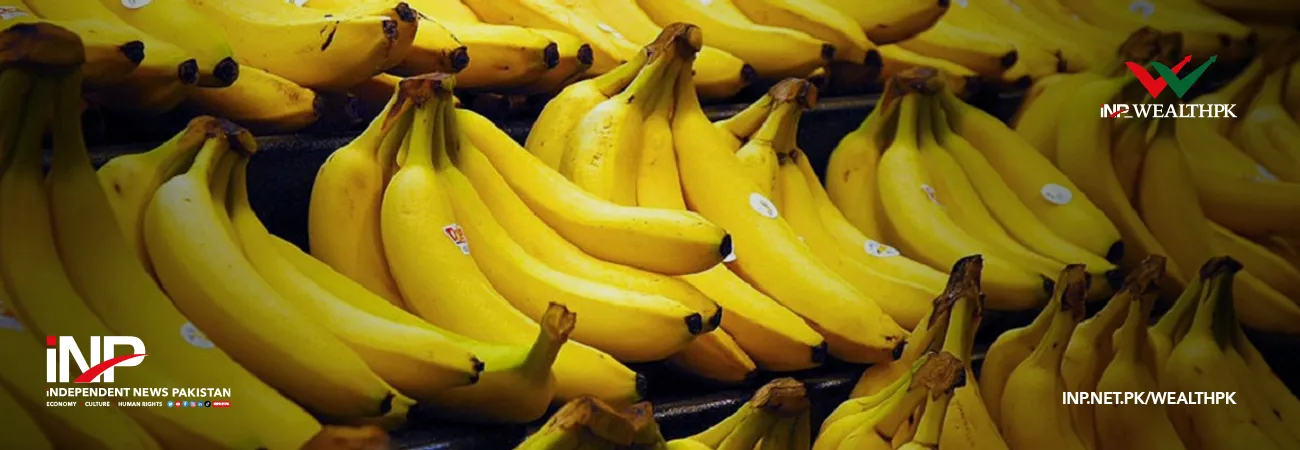INP-WealthPk
Shujauddin Qureshi
Over 85 percent of bananas grown in Pakistan come from Sindh. However, this southeastern province cannot export much of its produce due to irregular handling, bad packaging, lack of quality control, and poor storage and transportation facilities, WealthPK has learnt.

“So far, Pakistan exports bananas to Iran, Afghanistan, and Central Asian states by road and to the UAE and Saudi Arabia by air. Dhaka and Valium varieties are exported to Iran, Afghanistan, and Central Asian countries, while Bombay and G-9 varieties are supplied in the markets of Sindh and Punjab. Dhaka and Valium are larger in size and good in taste,” Fida Chohan, a leading banana farmer based in Tando Allahyar, told WealthPK.
“Bananas are one of the many fruits Pakistan grows that may have a good export potential; however, this potential is yet to be fully exploited,” Chohan said. According to the data from the Pakistan Bureau of Statistics (PBS) for FY2024, Pakistan exported approximately 212,109 metric tons of bananas, accounting for about 22.9 percent of the total fruit export volume of 410,802 metric tons.
Official statistics show that Pakistan exported around $36 million worth of bananas in 2024 — an increase of 96.6 percent from US$18 million in 2023. Even with this outstanding productivity, much of the fruit could not be exported because of structural problems, including poor cold storage facilities. A closer study shows that there are big chances to export the fruit to the Middle Eastern countries, but to avail them, the government needs to make smart investments and focus on policy.
According to Chohan, Thatta, Tando Allahyar, Khairpur, and Matiari districts grow much of bananas. Mild weather and rich soil aid banana production all year round. The seeds are mainly sown twice a year — February and November. Bombay is noted for its taste and health benefits, and it can successfully compete in the worldwide markets.
However, the post-harvest process in Pakistan is mostly traditional, restricting its shelf life and making the fruit unfit for export. A large part of the crop is lost or damaged before it gets to customers or potential exporters if there isn't enough cold storage and good logistics. “The shelf life of this fruit is very short, about three to four days, which is why it is exported less,” said Chohan.
The Middle East is a good market for Pakistani bananas because more Pakistani nationals are moving there. The earnings are appreciating, and the people are becoming more health-conscious. The United Arab Emirates, Saudi Arabia, Qatar, Oman, and Bahrain buy the bulk of this fruit every year. Much of the fruit comes from Latin America and the Philippines because Pakistani bananas don’t meet the quality standards of these marketplaces.
High-quality cold storage is a must for the fruit exports, and it is the main reason for the limited exports of Pakistani bananas. Another problem is the lack of standard packaging and grading. The exporters from competing nations employ high-tech tools to make sure that the colour and ripeness meet the set standards. This is something that retailers and consumers both prefer.
In addition, the Pakistani banana supply chain encounters problems like irregular handling, bad packaging material, and lack of quality control. Growers believe that even with these problems, there is still a lot of potential for the export of Pakistani bananas. Pakistan can greatly increase its exports by investing in cold storage facilities, packhouses, and transportation to keep the fruit at the right temperature.
Partnerships between the public and commercial sectors could be very important for this change. Setting up central hubs for processing bananas after harvest and facilitating export will let the small and medium-sized growers pool their crops and take advantage of economies of scale.
Credit: INP-WealthPk













